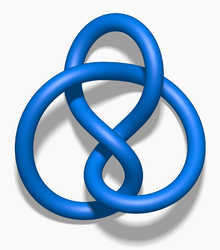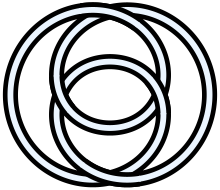Achterknoten Achterknoten Der Achterknoten (oder Achtknoten ) spielt in der Mathematik, speziell in der Knotentheorie , eine Rolle. Er ist das mathematische Gegenstück des Achtknotens , der unter anderem beim Segeln gebraucht wird.
Parameterdarstellung
Eine einfache Parameterdarstellung des Achterknotens ist:[ 1]
x
=
(
2
+
cos
(
2
t
)
)
cos
(
3
t
)
y
=
(
2
+
cos
(
2
t
)
)
sin
(
3
t
)
z
=
sin
(
4
t
)
{\displaystyle {\begin{aligned}x&=\left(2+\cos {(2t)}\right)\cos {(3t)}\\y&=\left(2+\cos {(2t)}\right)\sin {(3t)}\\z&=\sin {(4t)}\end{aligned}}}
Der Achterknoten ist der Abschluss des Zopfes
σ
1
σ
2
−
1
σ
1
σ
2
−
1
{\displaystyle \sigma _{1}\sigma _{2}^{-1}\sigma _{1}\sigma _{2}^{-1}}
Invarianten
Das Alexander-Polynom des Achterknotens ist
Δ
(
t
)
=
−
t
+
3
−
t
−
1
,
{\displaystyle \Delta (t)=-t+3-t^{-1},}
sein Jones-Polynom
V
(
q
)
=
q
2
−
q
+
1
−
q
−
1
+
q
−
2
.
{\displaystyle V(q)=q^{2}-q+1-q^{-1}+q^{-2}.}
Das Kauffman-Polynom ist
−
1
−
1
x
2
−
x
2
−
y
x
−
x
y
+
2
y
2
+
y
2
x
2
+
x
2
y
2
+
y
3
x
+
x
y
3
{\displaystyle -1-{\frac {1}{x^{2}}}-x^{2}-{\frac {y}{x}}-xy+2y^{2}+{\frac {y^{2}}{x^{2}}}+x^{2}y^{2}+{\frac {y^{3}}{x}}+xy^{3}}
HOMFLY-Polynom
x
2
+
1
x
2
−
y
2
−
1
{\displaystyle x^{2}+{\frac {1}{x^{2}}}-y^{2}-1}
Klammerpolynom
x
8
+
1
x
8
−
x
4
−
1
x
4
+
1
{\displaystyle x^{8}+{\frac {1}{x^{8}}}-x^{4}-{\frac {1}{x^{4}}}+1}
Conway-Polynom
1
−
x
2
{\displaystyle 1-x^{2}}
BLM-Polynom
2
x
3
+
4
x
2
−
2
x
−
3
{\displaystyle 2x^{3}+4x^{2}-2x-3}
Die Kreuzungszahl des Achterknotens ist 4, sein Geschlecht ist 1 und seine Seifert-Matrix
(
1
0
−
1
−
1
)
{\displaystyle \left({\begin{array}{cc}1&0\\-1&-1\end{array}}\right)}
Die Knotengruppe des Achterknotens hat die Präsentierung
Γ
=
⟨
a
,
b
∣
[
a
−
1
,
b
]
a
=
b
[
a
−
1
,
b
]
⟩
{\displaystyle \Gamma =\langle a,b\mid \left[a^{-1},b\right]a=b\left[a^{-1},b\right]\rangle }
Ihre Charaktervarietät
X
(
Γ
)
{\displaystyle X(\Gamma )}
[ 2]
z
2
=
u
3
−
2
u
+
1
,
{\displaystyle z^{2}=u^{3}-2u+1,}
das A-Polynom ist
−
M
4
+
L
(
1
−
M
2
−
2
M
4
−
M
6
=
M
8
)
−
L
2
M
4
.
{\displaystyle -M^{4}+L(1-M^{2}-2M^{4}-M^{6}=M^{8})-L^{2}M^{4}.}
Eigenschaften
Der Achterknoten ist achiral (auch amphichiral genannt), das heißt, er ist in sein Spiegelbild deformierbar.
Er ist kein Torusknoten .
Der Achterknoten ist ein hyperbolischer Knoten , sein hyperbolisches Volumen beträgt
v
o
l
(
S
3
−
K
)
=
2
D
2
(
ω
)
=
2
,
02
…
{\displaystyle vol(S^{3}-K)=2D_{2}(\omega )=2{,}02\dots }
Hierbei ist
D
2
{\displaystyle D_{2}}
Bloch-Wigner-Dilogarithmus und
ω
=
1
2
+
3
2
i
{\displaystyle \omega ={\frac {1}{2}}+{\frac {\sqrt {3}}{2}}i}
Die hyperbolische Struktur ist gegeben durch die treue und diskrete Darstellung
ρ
:
Γ
→
P
S
L
(
2
,
Z
[
ω
]
)
⊂
P
S
L
(
2
,
C
)
=
I
s
o
m
+
(
H
3
)
{\displaystyle \rho \colon \Gamma \to PSL(2,\mathbb {Z} \left[\omega \right])\subset PSL(2,\mathbb {C} )=Isom^{+}(H^{3})}
ρ
(
a
)
=
(
1
1
0
1
)
{\displaystyle \rho (a)=({\begin{array}{cc}1&1\\0&1\end{array}})}
ρ
(
b
)
=
(
1
0
−
ω
1
)
{\displaystyle \rho (b)=({\begin{array}{cc}1&0\\-\omega &1\end{array}})}
Die hyperbolische Struktur auf dem Komplement des Achterknotens wurde 1975 von Riley entdeckt.[ 3] Thurston zur Suche nach hyperbolischen Strukturen auf weiteren Knotenkomplementen, was letztlich in die Geometrisierungsvermutung mündete.
Der Achterknoten ist der einzige arithmetische hyperbolische Knoten.[ 4]
Cao und Meyerhoff haben 2001 bewiesen, dass der Achterknoten der hyperbolische Knoten kleinsten Volumens ist.[ 5]
Einfache quadratische Darstellung der Figur-acht-Konfiguration. Symmetrische Darstellung, die durch parametrische Gleichungen erzeugt wird. Seifert-Fläche für einen Achterknoten.
Siehe auch
Weblinks
Einzelnachweise
↑ Eric W. Weisstein : Figure Eight Knot .MathWorld ↑ Mehmet Haluk Șengün: An introduction to A-polynomials and their Mahler measures.
↑ Robert Riley : A quadratic parabolic group. Math. Proc. Cambridge Philos. Soc. 77 (1975), 281–288.↑ Alan Reid : Arithmeticity of Knot Complements. ↑ Chun Cao , Robert Meyerhoff : The orientable cusped hyperbolic 3-manifolds of minimum volume.











![{\displaystyle \Gamma =\langle a,b\mid \left[a^{-1},b\right]a=b\left[a^{-1},b\right]\rangle }](https://wikimedia.org/api/rest_v1/media/math/render/svg/9922cf6981f3844d900f096c6f2bc5a16cb7803e)






![{\displaystyle \rho \colon \Gamma \to PSL(2,\mathbb {Z} \left[\omega \right])\subset PSL(2,\mathbb {C} )=Isom^{+}(H^{3})}](https://wikimedia.org/api/rest_v1/media/math/render/svg/a436b466dbcefa53e42185c699cfa923c2fa5754)




